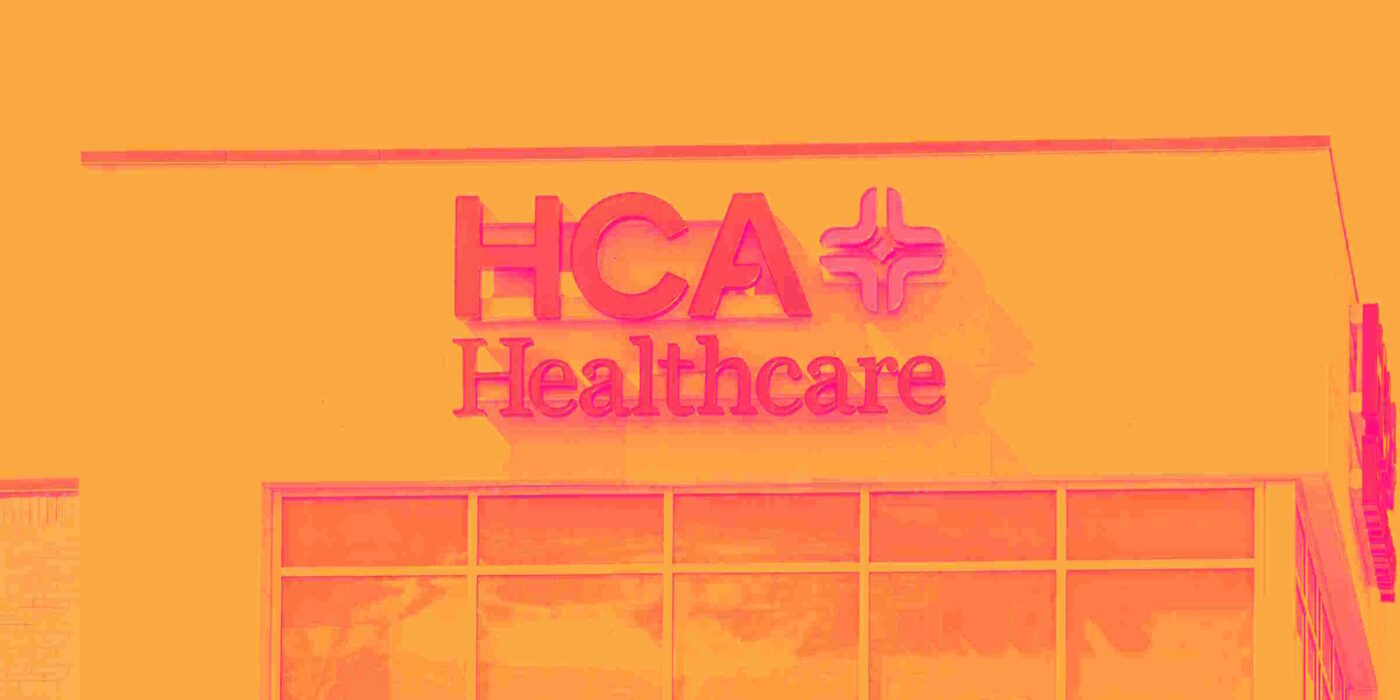
Hospital operator HCA Healthcare (NYSE: HCA) reported Q3 CY2025 results exceeding the market’s revenue expectations, with sales up 9.6% year on year to $19.16 billion. The company’s full-year revenue guidance of $75.75 billion at the midpoint came in 0.9% above analysts’ estimates. Its GAAP profit of $6.96 per share was 22.2% above analysts’ consensus estimates.
Is now the time to buy HCA? Find out in our full research report (it’s free for active Edge members).
HCA Healthcare (HCA) Q3 CY2025 Highlights:
- Revenue: $19.16 billion vs analyst estimates of $18.55 billion (9.6% year-on-year growth, 3.3% beat)
- EPS (GAAP): $6.96 vs analyst estimates of $5.70 (22.2% beat)
- Adjusted EBITDA: $3.87 billion vs analyst estimates of $3.48 billion (20.2% margin, 11.1% beat)
- The company slightly lifted its revenue guidance for the full year to $75.75 billion at the midpoint from $75 billion
- EPS (GAAP) guidance for the full year is $27.50 at the midpoint, beating analyst estimates by 4.5%
- EBITDA guidance for the full year is $15.45 billion at the midpoint, above analyst estimates of $15.07 billion
- Operating Margin: 15.5%, up from 13.8% in the same quarter last year
- Same-Store Sales rose 2.1% year on year (4.5% in the same quarter last year)
- Market Capitalization: $104.6 billion
StockStory’s Take
HCA Healthcare’s third quarter was marked by broad-based growth in patient volumes, improved payer mix, and higher utilization of complex services. Management highlighted the impact of increased Medicaid supplemental payments, particularly from Tennessee, Kansas, and Texas, as a significant factor supporting both revenue and margins. CEO Sam Hazen cited the “broad-based volume growth, improved payer mix, more utilization of complex services and additional revenue from Medicaid supplemental programs” as key drivers. The company also emphasized disciplined cost controls and operational execution, contributing to stronger operating margins compared to last year.
Looking forward, HCA Healthcare’s updated guidance is underpinned by expectations for stable demand across its markets and continued operational efficiency. Management pointed to ongoing investments in digital tools, expansion of outpatient facilities, and workforce development as initiatives to drive efficiency and capacity. CFO Mike Marks noted, “We continue to identify a robust set of opportunities across revenue and cost to improve efficiencies,” while cautioning that policy uncertainty around enhanced premium tax credits could impact demand. The company also highlighted its resiliency program and capital plans as central to sustaining performance in the coming year.
Key Insights from Management’s Remarks
Management pointed to a combination of Medicaid payment timing, payer mix improvements, and operational discipline as central to the quarter’s performance and margin expansion.
-
Medicaid supplemental payments: Revenue growth was significantly boosted by higher Medicaid state supplemental program payments, especially from approvals in Tennessee, Kansas, and Texas. Management noted these payments are complex and variable, contributing about half of the net revenue increase per admission for the quarter.
-
Payer mix shift: HCA saw increases in commercial and Medicare volumes, with commercial exchange admissions up 8% and Medicare up 3.4%, offsetting declines in self-pay admissions. This shift supported stronger revenue per admission and reflects continued demand for insured services.
-
Operational and cost management: Management credited improved labor and supply expense controls for margin gains. Contract labor expenses were flat year-over-year, and efforts to manage supplies—including contract renewals and technology adoption—helped contain cost pressures.
-
Service line and regional performance: Outpatient surgery volumes grew, with management highlighting strengths in general surgery, urology, and neurosciences. Though some regions faced lingering hurricane impacts, most divisions saw robust operational performance and capacity was not a constraint.
-
Resiliency program progress: HCA’s ongoing resiliency initiatives, which include digital transformation, benchmarking, and expanding shared service platforms, were cited as helping to maintain and advance operating margin gains. Management emphasized that these efforts are not one-time events but ongoing programs aimed at long-term efficiency.
Drivers of Future Performance
HCA’s outlook hinges on stable healthcare demand, further efficiency from resiliency initiatives, and navigating policy uncertainties affecting patient coverage.
-
Volume and service expansion: Management expects continued demand for healthcare services, driven by population growth in core markets, expansion of outpatient and inpatient capacity, and deeper relationships with physicians. These trends are expected to support volumes within the company’s long-term 2% to 3% growth range.
-
Policy and reimbursement risk: The company highlighted uncertainties around enhanced premium tax credits and Medicaid supplemental payments, noting that any changes in these programs could affect patient coverage and revenue. Management is closely watching ongoing state applications and federal policy developments.
-
Efficiency and digital investments: HCA plans to continue investing in digital tools, automation, and workforce development to drive operational improvements. The resiliency program, including AI pilots and benchmarking, is expected to yield further cost efficiencies and help offset inflationary and wage pressures.
Catalysts in Upcoming Quarters
In the coming quarters, the StockStory team will be monitoring (1) progress on Medicaid supplemental payment approvals in key states, (2) trends in commercial and Medicare patient volumes as the healthcare environment evolves, and (3) the effectiveness of HCA’s resiliency and digital transformation initiatives in driving margin improvements. Execution on capital investments and policy developments impacting patient coverage will also be important to track.
HCA Healthcare currently trades at $447.25, up from $440.07 just before the earnings. At this price, is it a buy or sell? See for yourself in our full research report (it’s free for active Edge members).
Stocks That Trumped Tariffs
When Trump unveiled his aggressive tariff plan in April 2025, markets tanked as investors feared a full-blown trade war. But those who panicked and sold missed the subsequent rebound that’s already erased most losses.
Don’t let fear keep you from great opportunities and take a look at Top 6 Stocks for this week. This is a curated list of our High Quality stocks that have generated a market-beating return of 183% over the last five years (as of March 31st 2025).
Stocks that made our list in 2020 include now familiar names such as Nvidia (+1,545% between March 2020 and March 2025) as well as under-the-radar businesses like the once-micro-cap company Kadant (+351% five-year return). Find your next big winner with StockStory today.
StockStory is growing and hiring equity analyst and marketing roles. Are you a 0 to 1 builder passionate about the markets and AI? See the open roles here.





